The exhibit “Walt Whitman: A Bicentennial Celebration” will celebrate the bicentennial of the birth of one of the most significant and influential writers in the United States, Walt Whitman (1819-1892), and highlight the University of Iowa’s role as a major center for Whitman Studies and Whitman scholarship. The exhibit features items held by the University of Iowa Libraries Special Collections that reveal the development of Whitman’s literary career from his days as a journalist and fiction writer to his moving accounts of his volunteer work in the Civil War hospitals in Washington, D.C., and from his radical poetic experiments in publishing Leaves of Grass to his efforts to preserve his legacy as “America’s Poet” in his last years. The exhibit presents some of Whitman’s most beloved and familiar poems, including “Song of Myself” and “Calamus,” as well as less familiar works, such as his first short story, “Death in the School-Room,” and his bestselling 1842 temperance novel Franklin Evans. It also showcases Whitman’s skills as a bookmaker and his enthusiasm for and involvement in the printing and physical construction of his evolving book; it traces his lifetime of work rearranging and redesigning Leaves of Grass. The items on display also demonstrate Whitman’s incredible literary afterlife, as his writings have been translated and published worldwide and preserved in physical and digital forms. At a political and historical moment when American values and understandings of what constitutes this nation are being questioned, this exhibit facilitates discussion about Whitman as an American poet in the nineteenth century, about how we have read him and his writings over the past two hundred years, and about the place of Whitman and his writing in the future of American and worldwide democracy.
Please join us for Walt Whitman at 200: The Bicentennial Symposium. Click here for the full listing of symposium events in April, May, and June.
Walt Whitman at 200 is made possible by a grant from the Arts and Humanities Initiative (AHI), Office of the Vice President for Research, University of Iowa.
SELECTED ITEMS
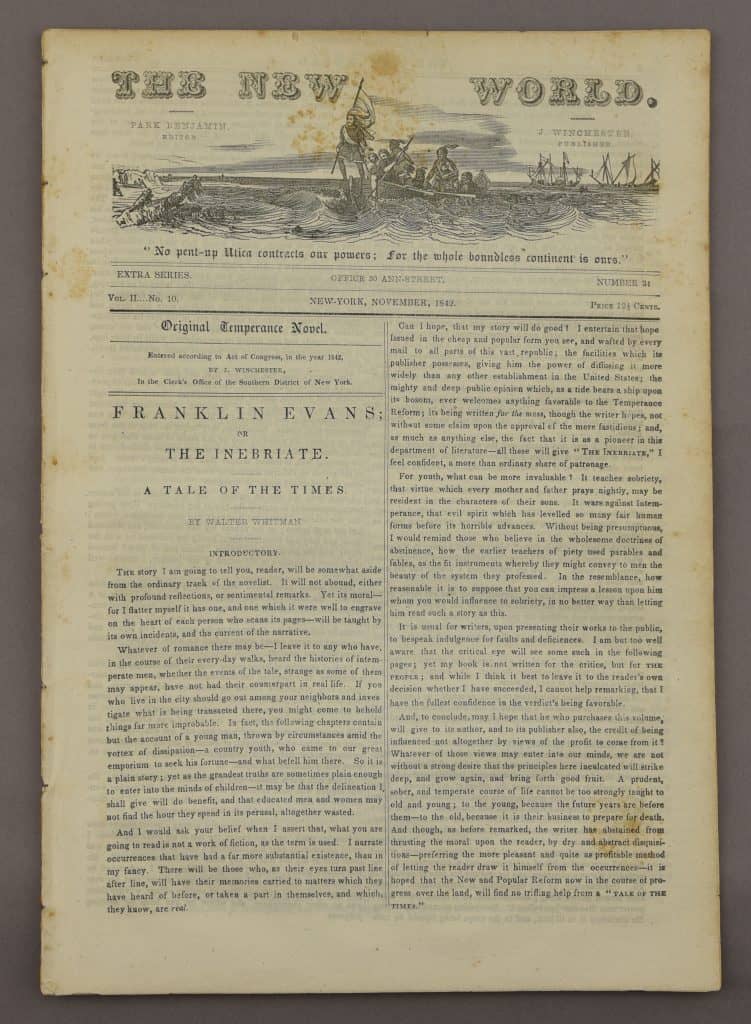 |
Franklin Evans; or the Inebriate. A Tale of the Times, The New World (extra edition) [New York, NY], November 1842. [in the catalog]
Throughout the 1840s and 1850s, Whitman wrote poetry with conventional rhyme and meter and popular fiction that ranged from moral and sentimental tales to stories focused on race, gender, sexuality, and national identity. In total, Whitman first published over twenty poems, twenty-six short stories, and two novels in New York newspapers and magazines by the early 1850s. His temperance novel Franklin Evans (1842) was published in a special edition of The New World and sold more than 20,000 copies |
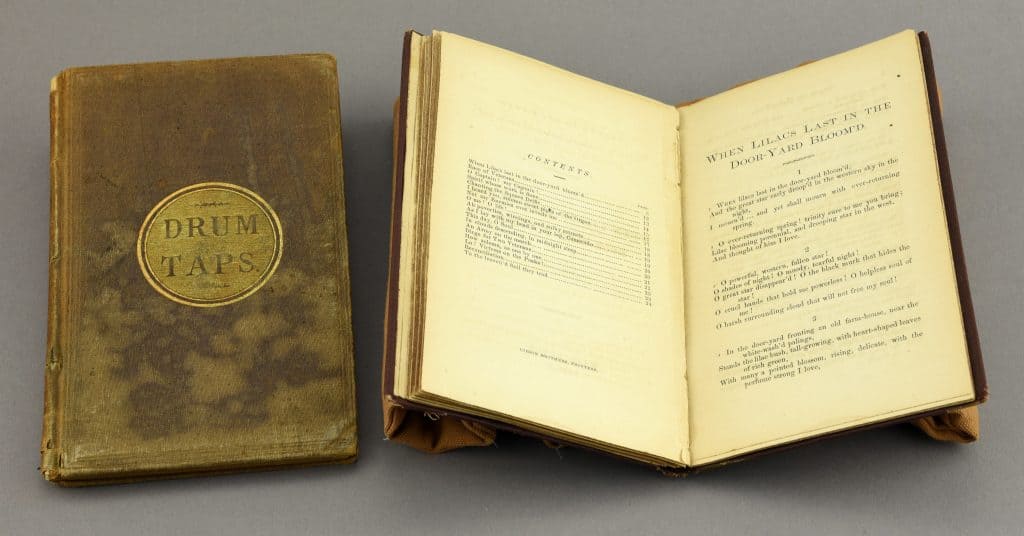 |
Drum-Taps. New York: Peter Eckler, 1865.
“When Lilacs Last in the Dooryard Bloom’d,” Sequel to Drum-Taps. Washington, D.C., 1865-1866. [in the catalog] Whitman’s volume of poetry Drum-Taps (1865) traces his evolving emotional responses to the Civil War, during which he volunteered as a caregiver in Washington. D.C. area hospitals. According to his own estimates in Memoranda During the War (1876), he made 600 hospital visits offering care and comfort to between 80,000 and 100,000 soldiers. |
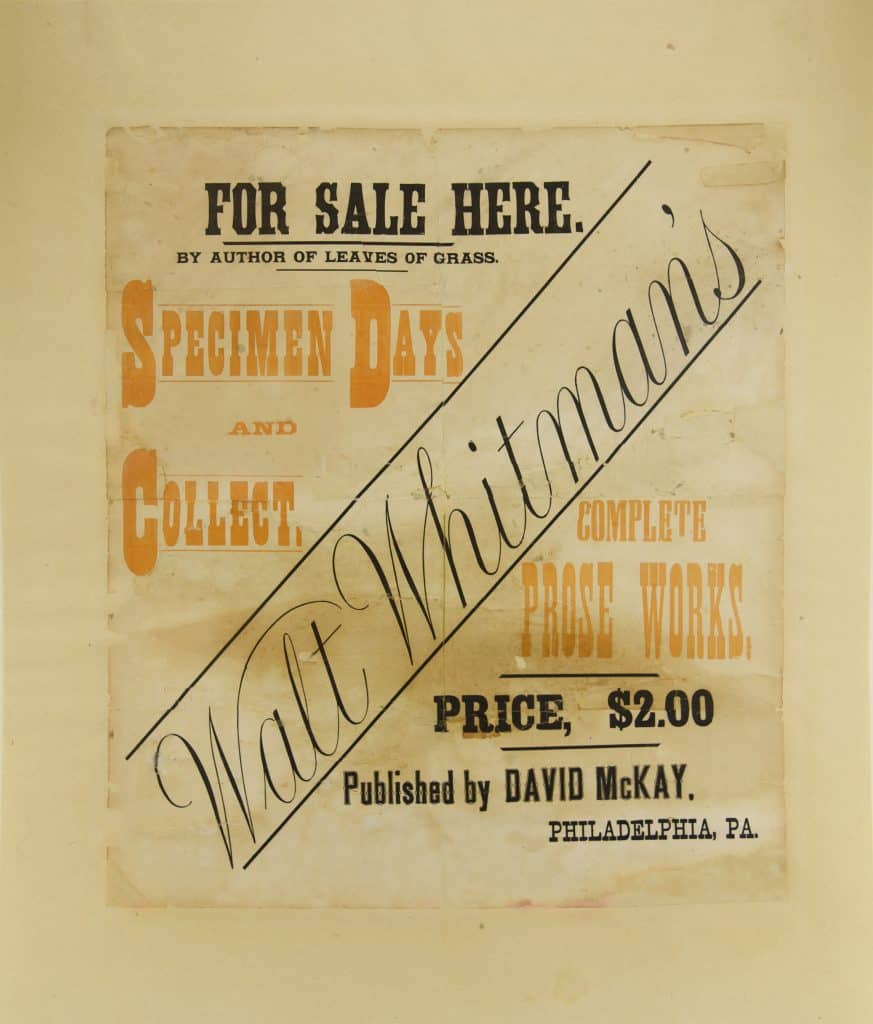 |
Original advertisement for Walt Whitman’s Specimen Days and Prose Works by David McKay, c. 1882. [in the catalog]
In Specimen Days (1882-83), a semi-autobiographical work, Whitman recounted his years in the hospitals, and the health problems he developed in the aftermath of the Civil War. More about David McKay, Whitman’s final publisher, on The Walt Whitman Archive. |
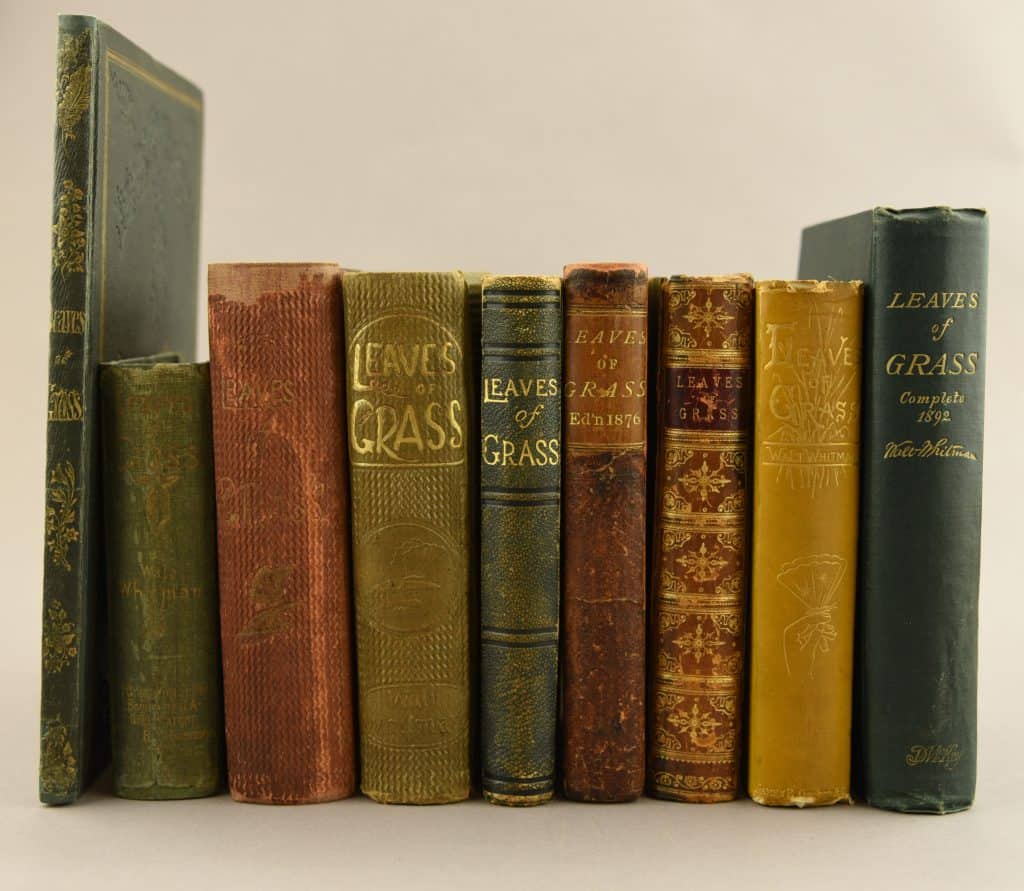 |
Editions of Leaves of Grass dating from 1855 through 1891-92.
Now considered a foundational text in US literature, Walt Whitman’s Leaves of Grass went through multiple significantly revised editions in his lifetime. The first edition (1855) contains a prose preface and twelve poems, including those later titled “Song of Myself” and “I Sing The Body Electric.” In a little over a year, the contents of Whitman’s volume grew into 32 poems for the second edition (1856), and by the third edition (1860) it boasted 156 poems. These first three editions contain many of the poems today’s readers associate with Whitman’s poetic voice, such as “Crossing Brooklyn Ferry,” “Song of the Open Road,” “I Saw in Louisiana a Live Oak Growing,” and “A Woman Waits for Me.” Whitman continued revising Leaves of Grass through subsequent editions, until by the “death-bed edition” of 1891-1892, the 389-poem volume is hardly recognizable from its original incarnation. Whitman’s editing impulse has spurred a debate as to which edition is “the best,” and readers now have access to various reissues of the first, third, and final editions in print, and online access to all the editions. As University of Iowa Whitman scholar Ed Folsom has suggested in Whitman Making Books/Books Making Whitman, “Whitman did not just write his book, he made his book, and he made it over and over again, each time producing a different material object that spoke to its readers in different ways.” |
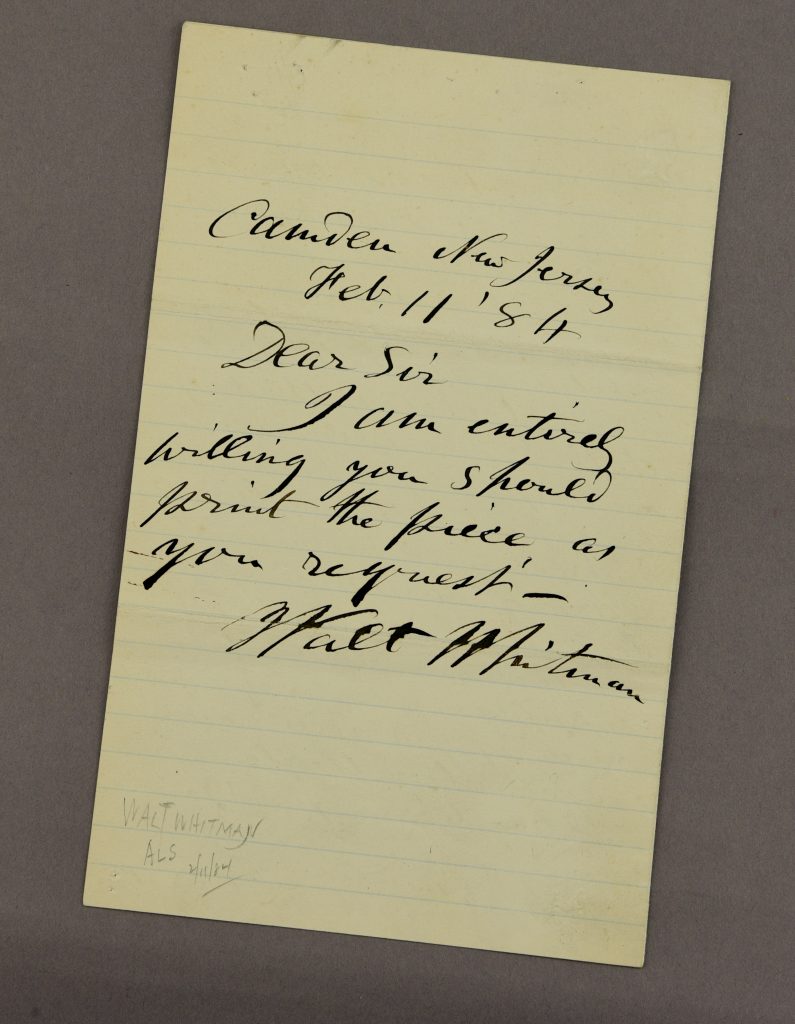 |
Letter from Walt Whitman to ornithologist Thomas Gentry (1843-1905), February 11, 1884, responding to Gentry’s February 8, 1884, letter.
Whitman was a prolific writer, not only of fiction and poetry; thousands of letters and manuscripts in Whitman’s hand are in public and private collections around the world. This exhibition features an assortment of items handled by Whitman, including a manuscript on Ralph Waldo Emerson, a postal card to the naturalist John Burroughs, and a letter to Philadelphia ornithologist Thomas Gentry (pictured here). |
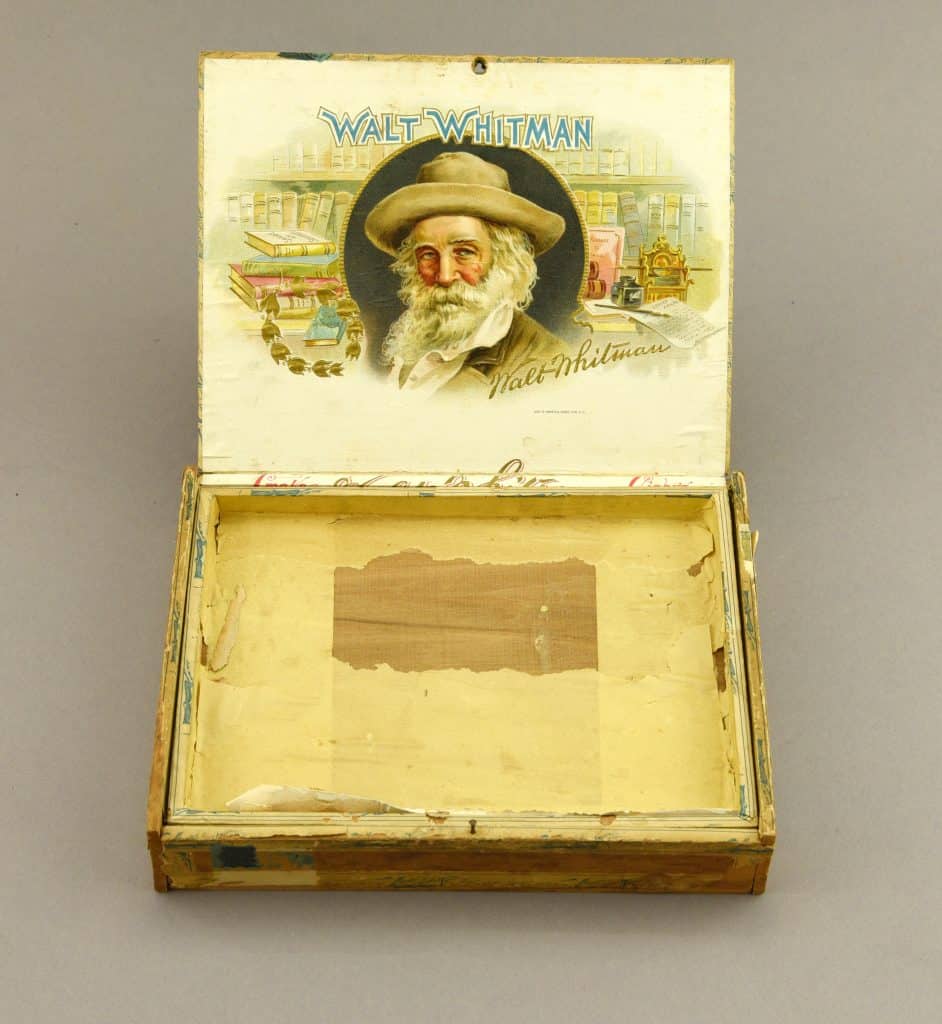 |
Walt Whitman brand cigar box with color lithograph by Geo. S. Harris & Sons, New York, NY. c. 1883-1893? [in the catalog]
Throughout his literary career, Whitman understood the importance of visual representations of himself in selling his books. Following this example, souvenir producers and commercial manufacturers saw value in reproducing Whitman’s name and likeness during and after his lifetime. Cigar boxes, beer bottles, an entire line of canned food, and T-shirts are just a few of the places where fans and readers have encountered the Whitman brand, ensuring that Walt Whitman remains a recognizable name and face nearly 130 years after his death. |
CREDITS
Exhibition Curation
Stephanie M. Blalock, Brandon James O’Neil, and Ed Folsom
Preparation & Installation
Giselle Simón & Bill Voss
Design
Kalmia Strong
Exhibit Coordination
Leah Morlan and Connor Hood
Touch Screen Design, Web Site, Publicity & Other Assistance
Jennifer Masada, Ken Clinkenbeard, Ethan DeGross, Alyssa Varner, Robert Shepard, Meghan Saak, and Marc Shepherd
Cataloging
Bethany Kluender
Contributing People & Institutions
Ed Folsom
Dr. Kendall Reed
Walt Whitman Archive
Walt Whitman Quarterly Review
University of Iowa Press
Financial Support for the Exhibition
Friends of the UI Libraries
Special Thanks
Margaret Gamm, Lindsay Moen, Elizabeth Riordan, Paula Balkenende and all graduate student employees in Special Collections in Fall 2018 and Spring 2019, Katie Hassman, John Culshaw, Paul Soderdahl, Mary Rettig, Tom Keegan and the Digital Scholarship and Publishing Studio, Brian Fotsch, and Whitman scholars, readers, teachers, and fans in Iowa and beyond
